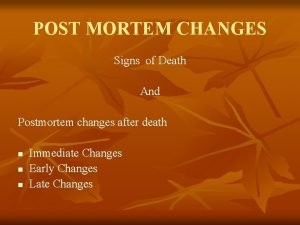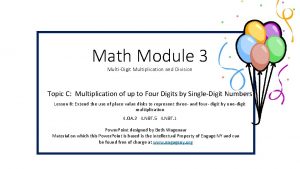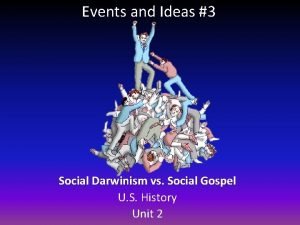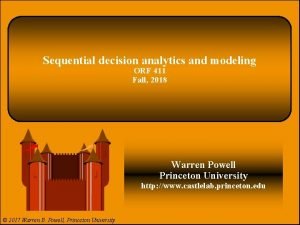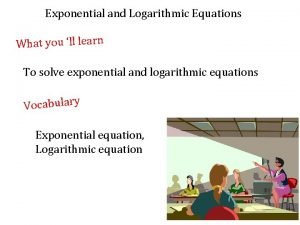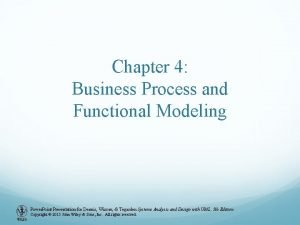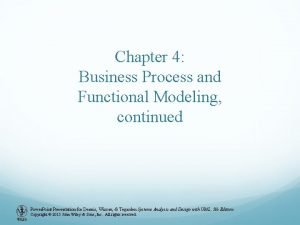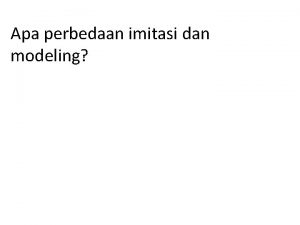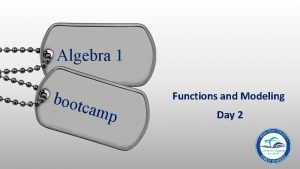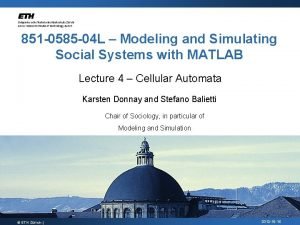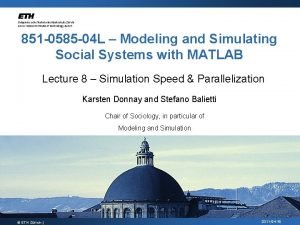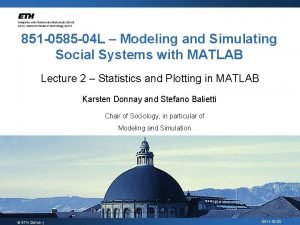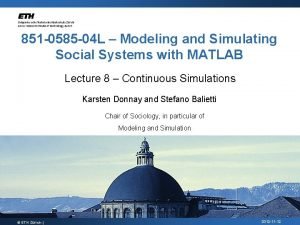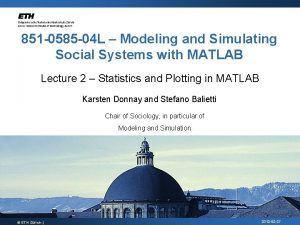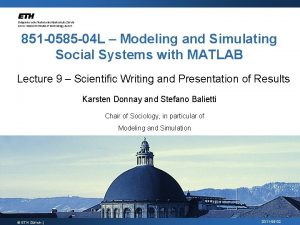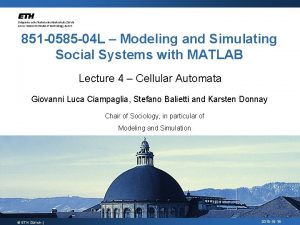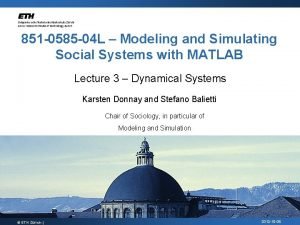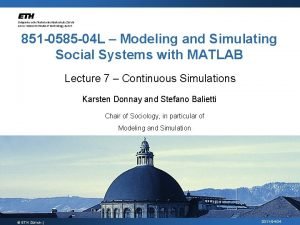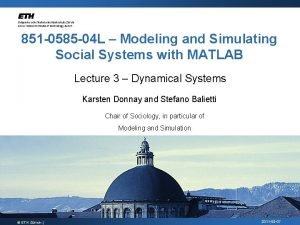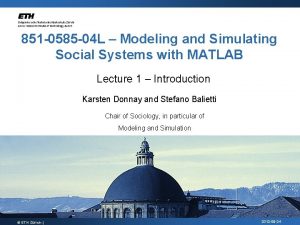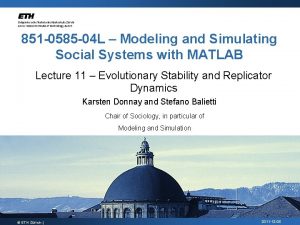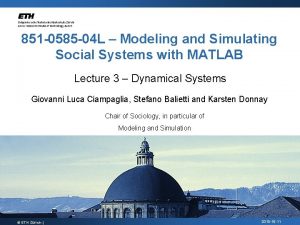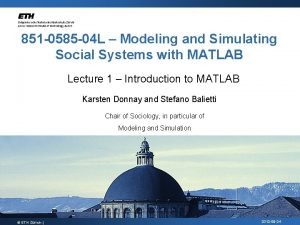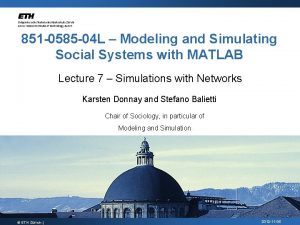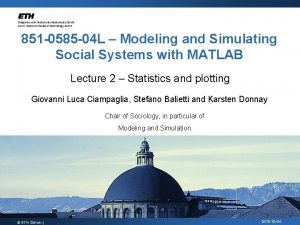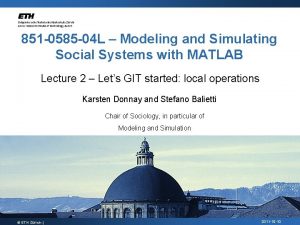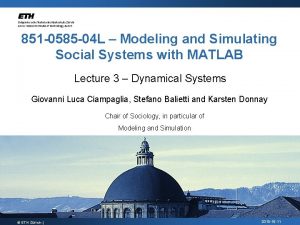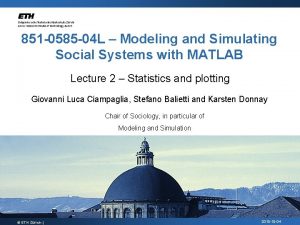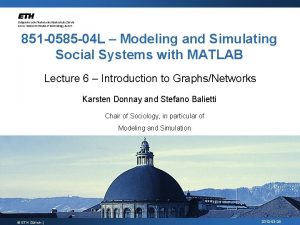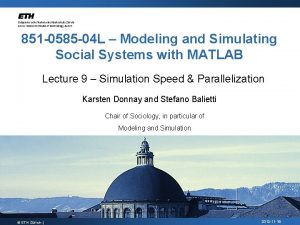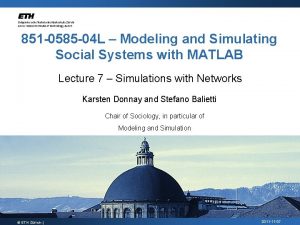851 0585 04 L Modeling and Simulating Social
























- Slides: 24

851 -0585 -04 L – Modeling and Simulating Social Systems with MATLAB Lecture 1 – Introduction Karsten Donnay and Stefano Balietti Chair of Sociology, in particular of Modeling and Simulation © ETH Zürich | 2012 -02 -20

Lecture 1 – Contents § Formalities: rules and goals of the course § Introduction to Modeling and Simulation § Introduction to GIT § What is MATLAB? § MATLAB basics: Variables, operators and data structures § Loops and conditional statements § Scripts and functions § § Exercises 2012 -02 -20 K. Donnay & S. Balietti / kdonnay@ethz. ch sbalietti@ethz. ch 2

Modelling and Simulating Social Systems with MATLAB Weekly lecture with computer exercises, each session will be split into about 30 -40 minutes lecture and 50 -60 minutes exercises. We will put the lecture slides and other material on this web page: www. soms. ethz. ch/matlab 2012 -02 -20 K. Donnay & S. Balietti / kdonnay@ethz. ch sbalietti@ethz. ch 3

How to contact us § in the lecture; please do not hesitate to approach us with any questions you might have § via email to kdonnay@ethz. ch or sbalietti@ethz. ch Important: to bypass the SPAM filter, start the subject line of your emails with: [MATLAB FS 12] e. g. [MATLAB FS 12] Ref. group dynamics 2012 -02 -20 K. Donnay & S. Balietti / kdonnay@ethz. ch sbalietti@ethz. ch 4

Mailing List § Send an email to: sympa@sympa. ethz. ch § � with text: SUBSCRIBE msssm Your Name § E. g. SUBSCRIBE msssm Karsten Donnay § Text to unsubscribe: SIGNOFF msssm 2012 -02 -20 K. Donnay & S. Balietti / kdonnay@ethz. ch sbalietti@ethz. ch 5

Purpose of the Mailing List § Foster cooperation among students 1. Discuss technical issues 2. Discuss organizational issues 3. Share code 4. Share references to literature 5. Share references to datasets 6. Form and communicate groups 2012 -02 -20 K. Donnay & S. Balietti / kdonnay@ethz. ch sbalietti@ethz. ch 6

Rules of the Mailing List 1. Be nice. 2. Be collaborative. 3. Do not post attachments. 1. 2. Add links to external resources. Enclose portions of code in tags <script> some code </script>. 4. Do not spam. 2012 -02 -20 K. Donnay & S. Balietti / kdonnay@ethz. ch sbalietti@ethz. ch 7

Examination Format (please also refer to the course description) Students earn their credit points by: 1. implementing an established mathematical model from the social science literature in MATLAB; 2. producing a ~30 page seminar thesis (code must be included) 3. Presenting the results it in a 15 minute seminar talk. § “Submission” of the work through Git. Hub www. github. com [more details later on in the lecture] 2012 -02 -20 K. Donnay & S. Balietti / kdonnay@ethz. ch sbalietti@ethz. ch 8

Seminar thesis Studying a scientific paper 2012 -02 -20 Reproducing results in MATLAB K. Donnay & S. Balietti / kdonnay@ethz. ch sbalietti@ethz. ch Writing a report and giving a talk 9

Projects from previous semesters Sugarscape Civil violence Group dynamics Trust Facebook social networks Space syntax Pedestrian dynamics Cycling strategies Tumour growth Segregation Cancer Traffic dynamics Swarms Sailing strategies Migration Flocks Cockroaches Arab Revolutions Civil war Queuing models Synchronized clapping Game theory tournament Game theory Language formation 2012 -02 -20 K. Donnay & S. Balietti / kdonnay@ethz. ch sbalietti@ethz. ch 10

Schedule of the course § The two first lectures will be spent on introducing the basic functionality of MATLAB: matrix operations, data structures, conditional statements, statistics, plotting, etc. § In later lectures, we will introduce various modeling approaches from the social sciences: dynamical systems, cellular automata, game theory, networks, multi-agent systems, … 2012 -02 -20 K. Donnay & S. Balietti / kdonnay@ethz. ch sbalietti@ethz. ch 11

Schedule of the course Introduction to MATLAB 20. 02. 27. 02. 05. 03. 12. 03. 19. 03. 26. 03. Working on projects (seminar thesis) 02. 04. 23. 04. 30. 04. Introduction to social-science modeling and simulations 07. 05. 14. 05. 21. 05. 28. 05. 2012 -02 -20 Handing in seminar thesis and giving a presentation K. Donnay & S. Balietti / kdonnay@ethz. ch sbalietti@ethz. ch 12

Schedule of the course § Please already take note of the dates for the hand-in and the oral presentation of your projects: § Deadline for project reports: Friday May 25 th 2012 at midnight § Oral project presentations: Tuesday May 29 th to Thursday May 31 st 2012 -02 -20 K. Donnay & S. Balietti / kdonnay@ethz. ch sbalietti@ethz. ch 13

Goals of the course: students will 1. Acquire firm understanding of the basics of MATLAB. 2. Attain practical knowledge of MATLAB necessary to run computer simulations. 3. Learning how to implement (simple) models of various social processes and systems, replicating and extending established models of the literature. 4. Develop independence in adequately individuating and selecting further literature (internet, books, paper…) to expand your knowledge of MATLAB 5. Become confident in presenting scientific results in academic context. 2012 -02 -20 K. Donnay & S. Balietti / kdonnay@ethz. ch sbalietti@ethz. ch 14

Requisites of the Course § Highly interdisciplinary course: § Physics, Sociology, Game Theory, Biology, Computer Science, Software Engineering… § Real requisites: 1. Hard work 2. Curiosity and creativity 3. Scientific Methods 2012 -02 -20 K. Donnay & S. Balietti / kdonnay@ethz. ch sbalietti@ethz. ch 15

Introduction to Modeling and Simulations Philipp Heer & Lukas Bühler (2011) MATLAB Project “Airplane Evacuation” 2012 -02 -20 K. Donnay & S. Balietti / kdonnay@ethz. ch sbalietti@ethz. ch 16

Introduction to Modeling and Simulations Fabio Crameri & Marcel Thielmann(2011) MATLAB Project “Evacuation Bottlenecks in Flooding Events” 2012 -02 -20 K. Donnay & S. Balietti / kdonnay@ethz. ch sbalietti@ethz. ch 17

Introduction to Modeling and Simulations Vittorio Megaro & Emanuele Rudel (2011) MATLAB Project “Desert Ant Behavior” 2012 -02 -20 K. Donnay & S. Balietti / kdonnay@ethz. ch sbalietti@ethz. ch 18

Introduction to Modeling and Simulations § We model to better understand our world § Simulations are a particular type of modeling § Simulations are relatively new § Predicting, discovering, formalizing § Entertainment (not the main purpose of the course!) 2012 -02 -20 K. Donnay & S. Balietti / kdonnay@ethz. ch sbalietti@ethz. ch 19

Emergence and Simulations § Focus on micro-mechanisms § Complexity theory § Emergence: “Interactions among objects at one level give rise to different types of objects at another level. ” 2012 -02 -20 K. Donnay & S. Balietti / kdonnay@ethz. ch sbalietti@ethz. ch 20

Emergence and Simulations Example of a Cellular Automata Game, Lecture 4 2012 -02 -20 K. Donnay & S. Balietti / kdonnay@ethz. ch sbalietti@ethz. ch 21

Modeling Cycle Simulation Model Simulated data Similarity Abstraction Social processes Data gathering Collected Data Source: Gilbert and Troitzsch (2005) 2012 -02 -20 K. Donnay & S. Balietti / kdonnay@ethz. ch sbalietti@ethz. ch 22

References § Gilbert, N. and Troitzsch K. G. “Simulation for the Social Scientist” 2 nd Ed. Open Uni. Press (2005) § Epstein J. M. and Axtell R. “Growing Artificial Societies. Social science from the bottom up” MIT Press (1996) § Epstein J. M. “Generative Social Science” Princeton Uni. Press (2006) 2012 -02 -20 K. Donnay & S. Balietti / kdonnay@ethz. ch sbalietti@ethz. ch 23

References § Helbing and Balietti “How to Do Agent-Based Simulations in the Future: From Modeling Social Mechanisms to Emergent Phenomena and Interactive Systems Design” (2011) http: //www. santafe. edu/media/workingpapers/1106 -024. pdf 2012 -02 -20 K. Donnay & S. Balietti / kdonnay@ethz. ch sbalietti@ethz. ch 24
 Post mortem changes
Post mortem changes Postmortem signs
Postmortem signs Modeling role modeling theory
Modeling role modeling theory 10 cfr 851
10 cfr 851 Health and safety act ontario
Health and safety act ontario 20 x 3
20 x 3 Dimensional modeling vs relational modeling
Dimensional modeling vs relational modeling National general 888-781-0585
National general 888-781-0585 Ngic 888-781-0585
Ngic 888-781-0585 Social thinking and social influence
Social thinking and social influence Social thinking social influence social relations
Social thinking social influence social relations Dfd symbols are referenced by using all
Dfd symbols are referenced by using all Linear and quadratic functions and modeling
Linear and quadratic functions and modeling Describe data and process modeling concepts and tools
Describe data and process modeling concepts and tools Social darwinism vs social gospel answer key
Social darwinism vs social gospel answer key Simulation kelton
Simulation kelton Sequential decision analytics and modeling
Sequential decision analytics and modeling Modeling with exponential and logarithmic equations quiz
Modeling with exponential and logarithmic equations quiz Dfd ch5
Dfd ch5 System requirements checklist output example
System requirements checklist output example Business process and functional modeling
Business process and functional modeling Business process and functional modeling
Business process and functional modeling Modeling and imitation training aba
Modeling and imitation training aba Determenistik
Determenistik Algebra 1 bootcamp functions and modeling
Algebra 1 bootcamp functions and modeling

